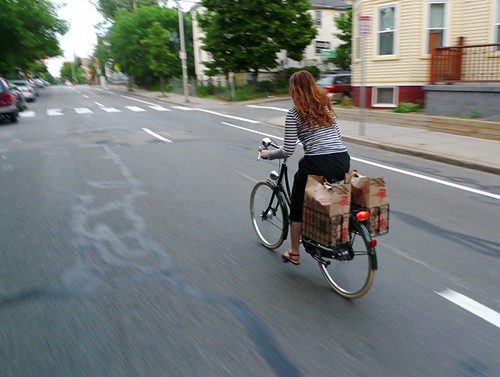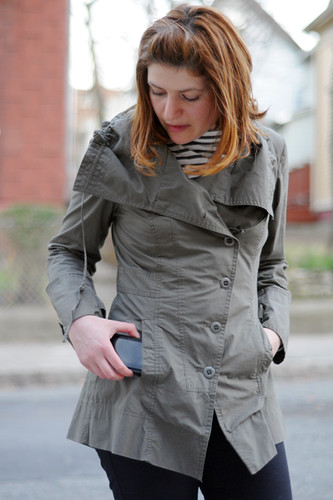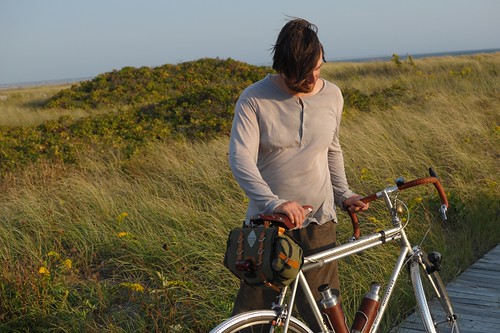
I hoped that I'd get over my tandem fever by now, but instead I have only grown more curious. So when local tandemnist Matt O'Keefe offered to take me on an early morning ride, I was there with bells on.Matt and his wife Susi have been riding tandem for years. They have one for the city and one for sport, both of which Matt -production managerat Seven Cycles,and welder at Merlin prior to that -built himself.
A former mountain bike racer, Matt's attitude to cycling is "the less pavement, the better." When we set off, he suggested we do an unpaved loop instead of going on the road. I had no objections.
I was actually very interested in the logistics of how a tandem would work where we were going. The thing about dirt roads in the Boston suburbs, is that they are more like trails: For the most part not technical, but quite narrow - at times claustrophobically so, with a path through the woodsjust wide enough to fit a single bike. They can also be twisty.I was curious how a tandem could be wrangled around corners through some of the trickier spots.
But neither the tight turns along the narrow parts of the path nor the sharply zig-zagging boardwalks across bogs were a problem: Matt steered the long machine with precision through gravel, dirt, mud and sand, over ruts and ditches, and around tight corners. Tandems really can go anywhere! The experience from the stoker's seat was fantastic. All I had to do was pedal, and the huge bike did all this cool stuff under Matt's captaining.
In this vein, I keep mulling over the idea that tandems are a great way to expose cyclists to styles of riding they are not yet comfortable with on their own. They could be a tool not only for couples and friends of disparate abilities, but also for cycling clubs and various organised events. For instance, I can imagine a club event where experienced tandem captains offer stoker spots for tours through gorgeous but tricky terrain. Or a tandem race, with stoker positions open to cyclists who would not race on their own. Just a thought, but it could be great fun... Then again, it could turn out like this. Either way, I am in!








 Cycling in greater Boston, I alternate between routes that take me along busy roads and routes that take me through quiet side streets. Each option leaves something to be desired. The busy roads are, well, busy - lots of car traffic, lots of action, lots of chaos. But they do seem to have enough room for everyone, including the processions of cyclists that now travel along them more than ever. The side streets are much quieter and greener, but are often too narrow to fit both a car and a bike side by side - resulting in its own set of challenges.
Cycling in greater Boston, I alternate between routes that take me along busy roads and routes that take me through quiet side streets. Each option leaves something to be desired. The busy roads are, well, busy - lots of car traffic, lots of action, lots of chaos. But they do seem to have enough room for everyone, including the processions of cyclists that now travel along them more than ever. The side streets are much quieter and greener, but are often too narrow to fit both a car and a bike side by side - resulting in its own set of challenges.








 1928 and 1934
1928 and 1934
 1936 and 1937
1936 and 1937
 1941 and 1942
1941 and 1942
 1943 – fifteen years old – yes, 15!
1943 – fifteen years old – yes, 15!
 1944 – sixteen years old
1944 – sixteen years old
 1945 (Junior Prom) and 1946
1945 (Junior Prom) and 1946 Once safely down on the other side, I found a place to sit and eat my lunch, along with several other folks. We chatted. They too were the ones who couldn't go on. They were waiting for their spouse to return from the top of Angels Landing. They weren't ashamed, perhaps a little embarrassed though. Four out of the five people waiting were men. Waiting for their wives to finish the climb.
Once safely down on the other side, I found a place to sit and eat my lunch, along with several other folks. We chatted. They too were the ones who couldn't go on. They were waiting for their spouse to return from the top of Angels Landing. They weren't ashamed, perhaps a little embarrassed though. Four out of the five people waiting were men. Waiting for their wives to finish the climb. Walking into an outdoor clothing and gear retailer today, we invariably see an expanse of merchandise that is stylised to portray outdoor pursuits as highly technical activities. Fabrics of unnatural textures emitting an otherworldly sheen, colour schemes that don't exist in nature, motifs based on jarring geometric forms, aggressive logo placements - the overall feel is decidedly inorganic. And perhaps that is the key to why I find the aesthetics of today's outdoor industry so disturbing: How can clothing and gear designed for an intimate relationship with our natural surroundings be made in a way that is so at odds with them?
Walking into an outdoor clothing and gear retailer today, we invariably see an expanse of merchandise that is stylised to portray outdoor pursuits as highly technical activities. Fabrics of unnatural textures emitting an otherworldly sheen, colour schemes that don't exist in nature, motifs based on jarring geometric forms, aggressive logo placements - the overall feel is decidedly inorganic. And perhaps that is the key to why I find the aesthetics of today's outdoor industry so disturbing: How can clothing and gear designed for an intimate relationship with our natural surroundings be made in a way that is so at odds with them? The view to Nikolaiviertel (Nikolai Quarter) and the Spree (river) from Muhlendamm (Mills Dam).
The view to Nikolaiviertel (Nikolai Quarter) and the Spree (river) from Muhlendamm (Mills Dam). The Spree and the Berliner Dom.
The Spree and the Berliner Dom.
 Statues and gold details on the Ephraim-Palais on Muhlendamm.
Statues and gold details on the Ephraim-Palais on Muhlendamm.

 Cosy Nikolai Quarter.
Cosy Nikolai Quarter.
 Nikolai Church and the Berlin bear.
Nikolai Church and the Berlin bear. Alexanderplatz, also called Alex by the locals.
Alexanderplatz, also called Alex by the locals.
 Neptunebrunnen (Neptune Fountain).
Neptunebrunnen (Neptune Fountain).
 The Rathaus (City Hall) and the Berliner Fernsehturm (TV Tower).
The Rathaus (City Hall) and the Berliner Fernsehturm (TV Tower).
 The Berliner Dom from the park on Spandauerstrasse.
The Berliner Dom from the park on Spandauerstrasse.


 The Berliner Dom (Berlin Cathedral).
The Berliner Dom (Berlin Cathedral). On Karl Liebknechtstrasse.
On Karl Liebknechtstrasse. Schlossplatz.
Schlossplatz.

 Altes Museum on Am Lustgarten.
Altes Museum on Am Lustgarten.
 Humboldt Box on Karl Liebknechtstrasse.
Humboldt Box on Karl Liebknechtstrasse.
 Alte National Gallery. Dutchman told me these could be bullet marks on the column.
Alte National Gallery. Dutchman told me these could be bullet marks on the column.